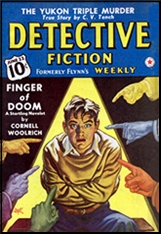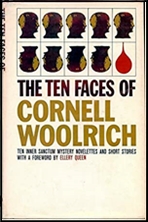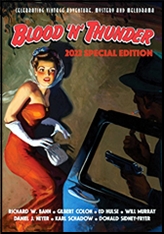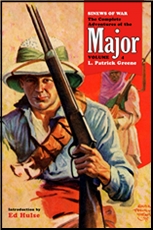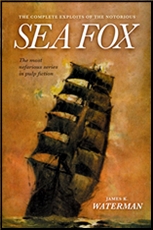2022 50th Anniversary PulpFest Convention Report,
by Walker Martin.
(Dedicated to the memory of Ed Kessel, Rusty Hevelin,
and Nils Hardin.)
50 Years! I attended the first Pulpcon in 1972 with my wife and we are among the very few survivors of this great, life changing convention. I say “life changing” because it seems that my entire life has revolved around pulp, book, and art collecting. Almost all my yearly vacations were scheduled to coincide with the convention dates and the show often overshadowed other major events in my life.

Though I started collecting in 1956 when I bought my first SF digest off the newsstand(I still have that issue of Galaxy), my collecting interests really increased a lot due to my attendance at Pulpcon and Pulpfest. My fondest memories are involved with this show and I’m still enthusiastic about collecting pulps and books even though I’ve been at it for 67 years. I may not need many wants anymore but I love collecting and attending the shows and talking to the many friends I’ve made over the years. It’s true that many of them are no longer with us but the memories live on.
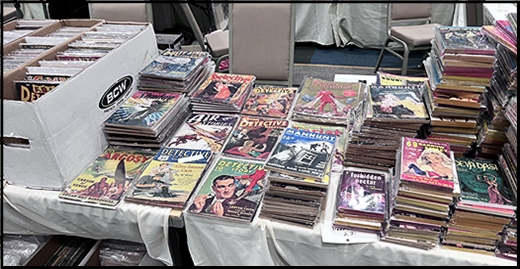
When Eleanor and I took the two day trip to St Louis in 1972 we were newly married and I drove a Volkswagon Beetle with no trouble at all. 50 years later, I no longer can drive long distances, but I have some good friends that do the driving. I think the great white rental van days are over, and this time Matt Moring of Steeger Books drove us in his big pickup truck. The storage area was just large enough for all the pulps and books that we bought.
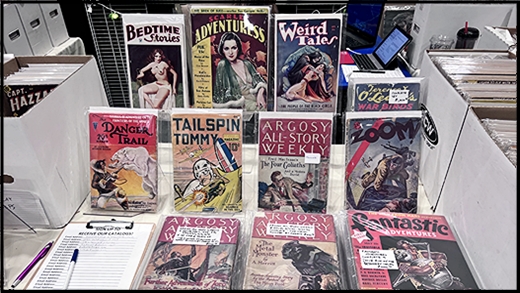
I was on the Pulpfest 50th anniversary panel and talked about the first convention. How Ed Kessel, the organizer, kept nervously taking off his hair piece. During the convention half the time he had hair and half he was bald. When he realized that he lost $500 putting on the show, he said that he would not do another one. But Rusty Hevelin saved Pulpcon by seeing that the convention continued each year.

This year there were almost 400 rabid collectors in attendance and around 100 tables. But 50 years ago there were less than 100 in attendance and around a dozen tables. What saved the convention in 1972 was Nils Hardin bringing in over a couple thousand pulps from the Fred Fitzgerald collection. Fitzgerald, who lived near St Louis in Festus, Missouri, died in the 1960’s and his widow advertised that his enormous collection was up for sale at her house. Price was cover price! Ed Kessel, Earl Kussman, and Nils Hardin drove out and while Ed and Earl cherry picked SF and Hero pulps, Nils bought extensive runs of Argosy, Bluebook, Short Stories, Adventure, Complete Stories, Top Notch. Not to mention all sorts of detective pulps.

Many of these pulps I obtained often had Fred Fitzgerald’s name on the cover and words circled inside in blue and red ink. In fact when I was drafted into the army, I spent time at Fort Leonard Wood, Missouri and I used to date a girl in Festus. She was divorced with two children and I met her at a dive called Whiskey-A-Go-Go. Little did I know that a mother load of pulps were in the small town. If I had known then I would gladly have dumped her and carried on a bookish romance with the pulps.
(Ed Hulse and Walker Martin in photo to right.)
We had some stellar guests at the first Pulpcon. How’s this for some names: Graves Gladney, the Shadow cover artist; Leigh Brackett, the SF writer, and Edmond Hamilton, her husband and also a SF writer. 50 years later in 2022 we had no guests, mainly because all the pulp writers and artists are long gone.
On the 50 Years of Pulfest panel we had several other collectors, each one representing a different decade.
1970’s–Walker Martin and Jack Cullers
1980’s–Don Hutchison(I believe Don is our oldest attendee at 91)
1990’s–Tony Davis
2000’s–Bill Lampkin and maybe also William Patrick Maynard. I forget since I was so excited to be talking about Pulpcon #1.
2010’s–Sara Light-Waller
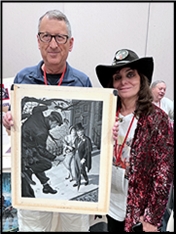
Prior to the panel we had Pizza at Pulpfest, sponsored by many of the dealers. I tried to control my beer drinking since I was on the panel right after the pizza party and I seem to remember talking about some risque events that occurred at the early Pulpcons. Sorry if I offended anyone.
(Paul Herman with wife of artist Samson Pollen in photo to left.)
Following the 50 Year panel, Dave Saunders gave another one of his excellent discussions on a pulp artist. This year it was about Nick Eggenhoffer, who was the main illustrator for the western pulps and in my opinion, the best. Then we had Ed Hulse and Garyn Roberts talking about Dime Mystery, followed by Morgan Holmes on Robert Howard and Fiction House. Then a FarmerCon panel followed by King of the Royal Mounted, a serial.
Pulpfest is known for its great programming and in addition to the evening programs, there were also afternoon panels, all of which I missed since I can’t tear myself away from the dealer’s room. Once a collector, always a collector. Then Friday night we had Robert Deis and Wyatt Doyle talking about George Gross and his career as an artist for the men’s adventure magazines, followed by Ed Hulse and Will Murray talking about the hardboiled west. Also discussions of Fiction House comics, Planet Stories, and Meteor House.

Saturday Rick Lai was awarded the Munsey Award for his books and essays on the pulp magazines. He’s been at it for decades. We then had the auction which mainly consisted of magazines from the Carl Joecks Estate. Over two hundred small lots. Not much I wanted to bid on until the end when Samson Pollen’s art came up for bid. Unfortunately I developed leg and knee pains and had to leave the auction early. As I limped out I cursed getting old but I guess that’s better than the alternative.

Issue #31 of The Pulpster was the usual impressive job done by William Lampkin the editor and Mike Chomko, the Publisher. There were several articles on Fiction House at 100 and also articles on slabbing pulps, Dime Mystery, Church of Satan, William Lindsay Gresham, The Avenger, Zane Grey, and Rusty Hevelin. By the way, the slabbing of pulps in plastic is coming but I was glad to see no examples yet in the dealer’s room. I believe books and pulps should be read and cared for, not treated like the comic books as investments.

I had my usual table and sold many cancelled checks made out to pulp authors. Also sold DVD’s and miscellaneous pulps. Several years ago, Matt Moring traded me a cover painting from People’s Story Magazine for February 10, 1922, which is a hundred years ago. I celebrated the event by finding the magazine at Doug Ellis’ table. Thanks for finding it Matt!
I also bought 25 issues of Mammoth Detective, one of the crazier titles. I seem to remember having and reading these issues decades ago. Time to reread them! I also found six issues of Black Mask from the Joe Shaw era without covers. Time to reread them also. I almost bought several pieces of original art but I talked myself out of buying art since I don’t have any wall space left.

Making their debut at Pulpfest were several books such as George Gross Covered by Bob Deis and Wyatt Doyle, Pulp Power, a big coffee table book full of Street & Smith pulp covers, and the usual big selection of Steeger Books new releases. Matt Moring of Steeger Books has passed the 600 book mark I believe and should be in Ripley’s Believe It or Not. The books are all in the Black Mask Library series:
Jerry Frost by Horace McCoy
Cellini Smith by Robert Reeves
The Human Encyclopedia by Frank Gruber
Jerry Tracy by Theodore Tinsley
It Happened at the Lake by Joseph Shaw
This was a great Pulpfest, one of the best and you are missing an excellent time out if you miss it in the future. The Pulpfest Committee does an outstanding job and I have to thank Jack and Sally Cullers, Mike Chomko, Barry Traylor, Bill Lampkin, William Patrick Maynard, and Sara Light-Waller. There were other volunteers also that deserve thanks, and to Paul Herman for providing the photos you see above. I hope to see some of you next year!

